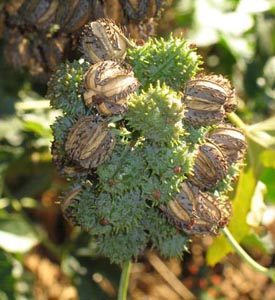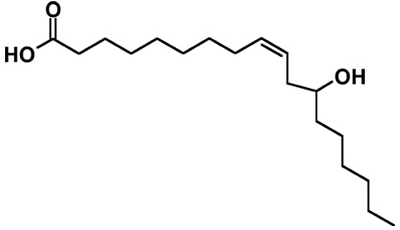
The castor hydroxylase, FAH12 produces ricinoleic acid. Ricinoleate and derivatives are found in lubricants, nylon, dyes, soaps, inks, and adhesives. Industrial processes consume 600-800 million lbs of hydroxyl fatty acids each year, and demand is growing rapidly.
The hydroxy fatty acid ricinoleate (12-hydroxy-octadeca-cis-9-enoic acid: 18:1-OH) is an important natural raw material with great value as a petrochemical replacement in a variety of industrial processes. Its derivatives are found in products such as lubricants, nylon, dyes, soaps, inks, adhesives, and biodiesel. The seeds of castor plant (Ricinus communis L.) are the major source of ricinoleate, which constitutes about 90% of the total fatty acids of the seed oil. However, oilseed castor cultivation is limited to tropical and sub-tropical regions, and seeds are laboriously harvested by methods that are difficult to adapt to large-scale production. In addition, castor seeds contain the poisonous ricin as well as strongly allergenic 2S albumins, which pose health threats for workers during planting, harvesting and processing. It is therefore highly desirable to produce ricinoleate in temperate oilseed crops through genetic engineering.
Ricinoleate biosynthesis in castor seeds is catalyzed by an oleate Δ12-hydroxylase (FAH12), which adds a hydroxyl group (-OH) to the twelfth carbon of oleic acid moieties esterified to the sn-2 position of phosphatidylcholine [1]. Expression of FAH12 in transgenic tobacco and Arabidopsis caused the accumulation of hydroxy fatty acids, but only to about 17% of total seed oil, far less than that in the native castor seeds [2]. To increase ricinoleate in transgenic oilseeds and create a castor oil replacement, it is necessary to better understand the mechanisms of lipid metabolism in castor seed. We are specifically interested in the expression profile of genes that are co-expressed with the FAH12 gene because some of these gene products may also contribute to ricinoleate accumulation in developing castor seeds. We also developed a high-throughput approach that in principle can allow testing of the entire transcriptome of developing castor seed endosperm by shotgun transforming a full-length cDNA library into a FAH12-expressing Arabidopsis line [2]. The genes that are identified in this project to be major contributors for ricinoleate accumulation will be co-expressed in order to create novel, high-value oil traits in oilseed crops.
